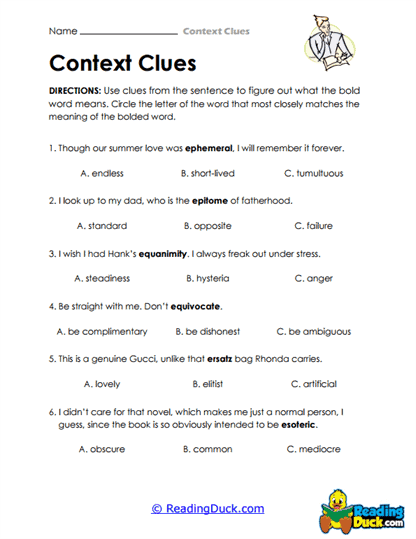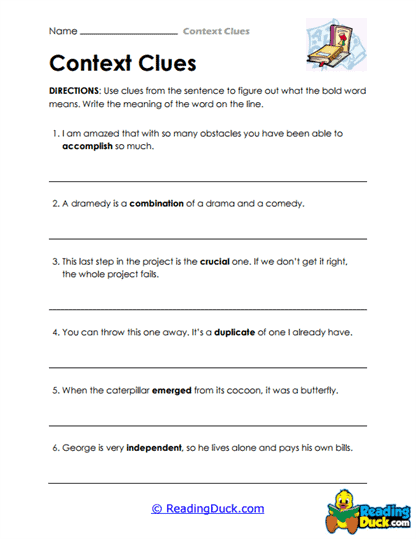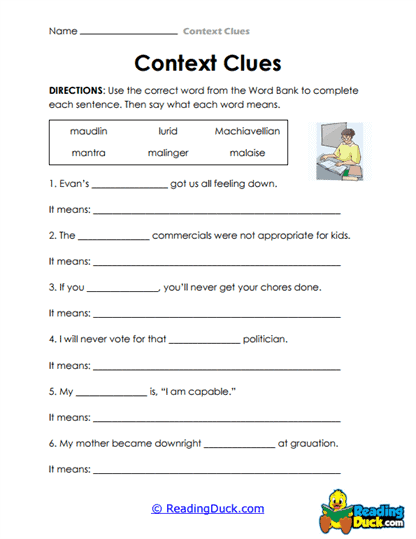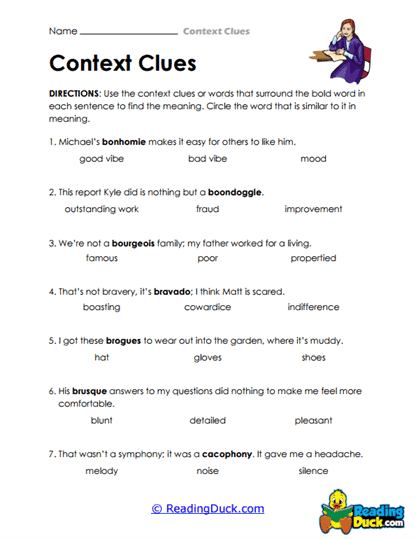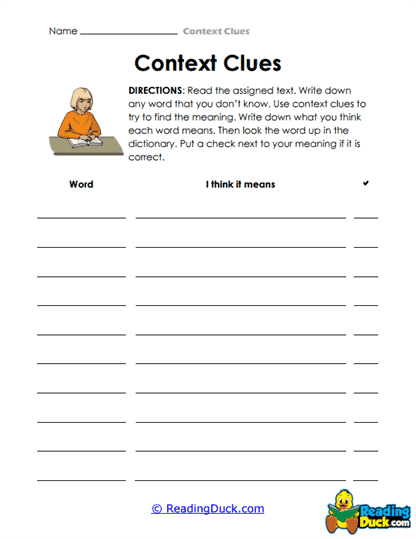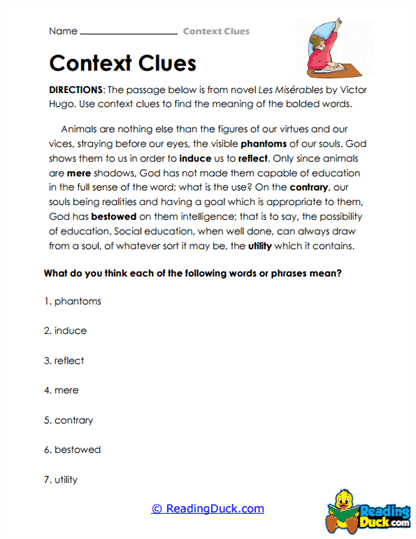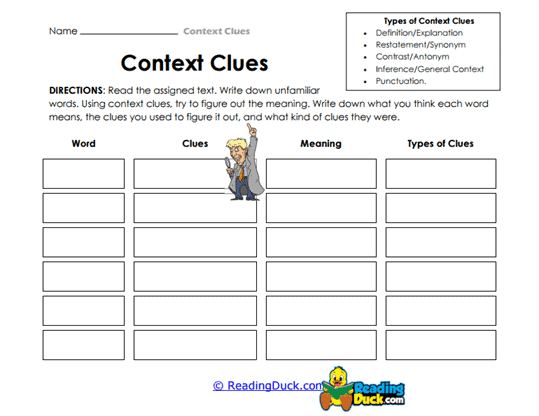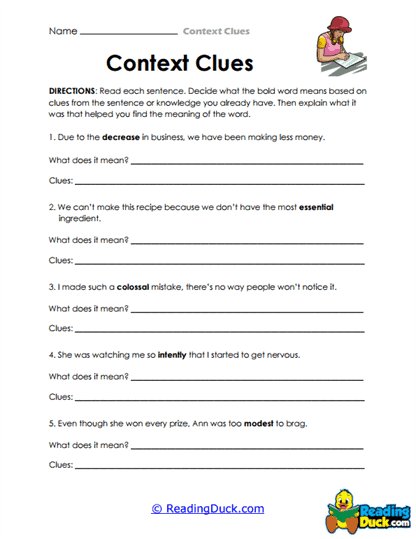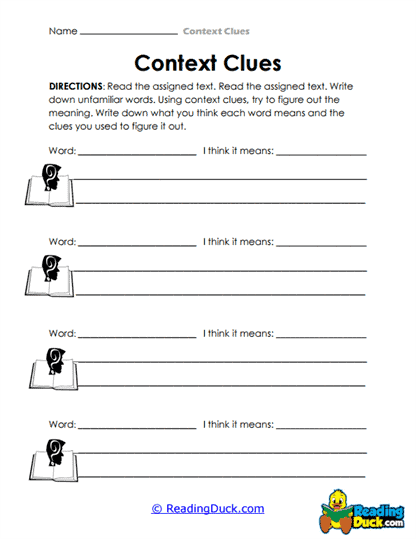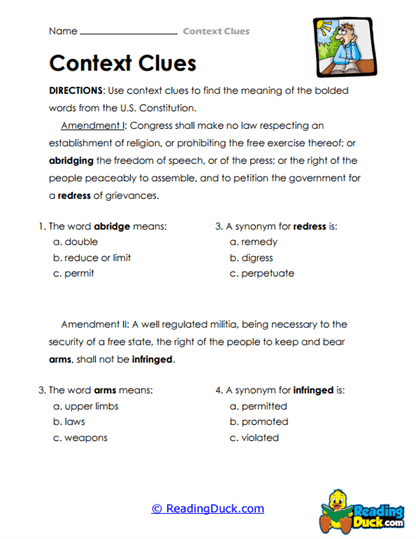Context Clues Worksheets
About Our Context Clues Worksheets
Our Context Clues Worksheets are designed to help students develop essential reading and writing skills by teaching them how to deduce the meaning of unfamiliar words using the surrounding text. This foundational skill is crucial for improving reading comprehension, vocabulary development, and critical thinking, making it an indispensable tool for academic success across all subjects. Each worksheet in this collection is presented in PDF format, making it easy to download, print, and use in both classroom and home learning environments. Additionally, every worksheet comes with a downloadable answer key, allowing for quick assessment and feedback.
These worksheets are versatile and adaptable for various grade levels and learning paces, making them an excellent resource for educators, parents, and students looking to enhance language skills through practical and engaging exercises.
Understanding Context Clues and Their Importance
Context clues are hints or pieces of information provided in the surrounding text that help readers infer the meaning of unfamiliar words. Mastering the ability to use context clues empowers students to become more independent readers, allowing them to tackle challenging texts without relying on a dictionary for every unfamiliar word. These worksheets focus on different types of context clues, such as:
- Definition Clues: The meaning of a word is directly or indirectly provided in the sentence or passage.
- Synonym/Antonym Clues: Similar or opposite words within the text give hints about the meaning of the unfamiliar word.
- Inference Clues: The reader must deduce the meaning of the word based on surrounding information, even when no direct definition is provided.
Teaching students how to effectively use these clues strengthens their overall reading comprehension by allowing them to engage more deeply with the text. These skills are essential not only in language arts but across subjects like history, science, and social studies, where students frequently encounter unfamiliar vocabulary.
For instance, if a student reads the sentence, "The weather was balmy, perfect for a relaxing day at the beach," they can infer that balmy means something pleasant or warm, even if they haven't encountered the word before. Learning how to recognize these clues builds students’ confidence in navigating complex readings.
Integrating Context Clues Worksheets into Broader Lessons
The Context Clues Worksheets are versatile tools that can be seamlessly integrated into larger units or projects, enhancing student learning and helping teachers meet a variety of educational objectives. Whether used in language arts, social studies, or science, these worksheets provide a foundation for deeper understanding and engagement with texts.
Ways to Integrate Context Clues into Larger Projects:
- Literary Analysis: Use the worksheets as part of a broader unit on reading comprehension, encouraging students to analyze unfamiliar vocabulary in literary texts, poems, or plays. By identifying context clues in these genres, students can better appreciate the nuanced language used by authors.
- Essay Writing: Incorporate context clues exercises to help students expand their vocabulary and improve their writing. As students learn to decipher the meaning of new words through context, they can incorporate more sophisticated vocabulary into their own essays and creative writing.
- History and Science Lessons: In content-heavy subjects like history or science, context clues worksheets can help students navigate difficult texts, such as primary sources or scientific papers, without being overwhelmed by specialized vocabulary.
By integrating these worksheets into your curriculum, you provide students with the skills to independently tackle complex readings, enriching their understanding of both the content and the language used to express it.
Encouraging Student Engagement and Motivation
One of the most important benefits of our Context Clues Worksheets is how they keep students engaged and motivated throughout the learning process. These worksheets offer interactive, thought-provoking exercises that challenge students to think critically, making learning both fun and rewarding.
How These Worksheets Promote Engagement:
- Interactive exercises: Students are actively involved in deciphering the meaning of words rather than passively receiving definitions, promoting a hands-on approach to learning.
- Instant feedback: With downloadable answer keys, students can immediately check their work and track their progress, which helps them stay motivated as they see improvement.
- Independent study: The flexibility of these worksheets makes them ideal for students to use on their own, allowing them to take ownership of their learning process and practice at their own pace.
Incorporating these worksheets into your lessons ensures that students remain focused and engaged while developing crucial reading and writing skills. By giving students the tools to independently solve language puzzles, you foster a sense of accomplishment and confidence in their abilities.
Complementary Activities to Reinforce Learning
To enhance the learning experience and reinforce the skills developed through our Context Clues Worksheets, teachers can pair these exercises with complementary activities that extend students' understanding and apply their new vocabulary in creative ways.
Suggested Complementary Activities:
- Group Discussions: After completing a worksheet, have students work in groups to discuss the unfamiliar words they encountered. They can share the context clues they used to determine the meanings and compare their findings.
- Context Clue Scavenger Hunt: Challenge students to find and identify context clues in a passage from a novel, article, or poem, turning reading into an interactive game.
- Vocabulary Journals: Encourage students to keep a vocabulary journal where they record new words they encounter, along with the context clues they used to figure out the meaning.
- Creative Writing: Ask students to write their own short stories or paragraphs that include unfamiliar words, challenging their peers to use context clues to determine the meaning.
These activities not only reinforce the concept of context clues but also make learning more collaborative and engaging, ensuring that students apply what they've learned in meaningful, practical ways.
Ideal Grade Levels and Adaptability
The Context Clues Worksheets are designed to be effective for a wide range of grade levels, making them a valuable resource for both elementary and secondary education.
Recommended Grade Levels:
- Elementary School (Grades 3-5): Focus on introducing basic vocabulary and straightforward context clues in simple texts.
- Middle School (Grades 6-8): Engage students with more complex passages, encouraging deeper inference and critical thinking skills.
- High School (Grades 9-12): Challenge advanced students with abstract vocabulary, preparing them for SAT or ACT exams and higher-level academic texts.
The worksheets can be easily adjusted to suit different skill levels, ensuring that all students are able to participate meaningfully. Teachers can select worksheets that match the reading level of their class, making these worksheets an ideal fit for differentiated instruction.
Supporting Project-Based Learning and Real-World Applications
Our Context Clues Worksheets are also a valuable tool for project-based learning, where students apply their skills in real-world contexts. By integrating these worksheets into larger, collaborative projects, students can deepen their understanding of how vocabulary and context clues function in various fields.
Project-Based Learning Ideas:
- Research Projects: Assign students a topic to research, and have them use context clues to navigate complex informational texts. This project encourages independent research and critical analysis of new vocabulary.
- Debates and Presentations: Use context clues as part of a larger project, such as a debate or presentation, where students must understand and explain advanced terms in their arguments.
- Creative Storytelling: Incorporate context clues into a creative writing assignment where students must use unfamiliar words within their own stories, encouraging them to think about how language shapes meaning.
These projects not only reinforce the context clues skills learned in the worksheets but also promote collaboration, deeper understanding, and the application of knowledge in engaging, real-world ways.
Conclusion
Our Context Clues Worksheets offer an invaluable resource for educators, parents, and students aiming to build strong reading and writing skills. These worksheets help students develop the ability to infer the meaning of unfamiliar words, improving vocabulary, critical thinking, and reading comprehension. With adaptable exercises, interactive content, and opportunities for independent study, these worksheets foster a love of language and encourage students to become confident, skilled readers. By integrating them into your curriculum, you provide students with the tools they need for academic success across multiple subjects and grade levels.
